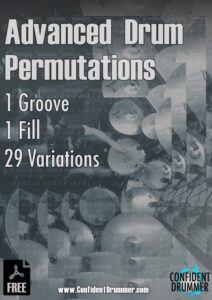If you have been reading my content for a while you probably noticed that I sound like a broken record when it comes to powerful practice techniques. I believe the idea of focusing on the ‘how’ of what we study is the cornerstone of improving quickly and taking our drumming skills to the next level.
I introduced the concept of parameters in this post, and then explored a few parameters like dynamics and tempo in other articles.
Parameters are nothing more than variables that we lay on top of whatever we are playing, with the goal to enhance its expressive potential. They go beyond the ‘what’ involved in what we are doing.
Today we are going to learn how to use a new one, called permutation, which is an exceptionally useful tool for us drummers, if we want to fully comprehend an exercise.
To permutate simply means to play a given phrase/beat using the same identical succession of notes, with the only difference that we always start in different parts of the measure, and therefore we shift the entire idea on the reference grid (subdivision), assigning a new ‘one’ to it.
In other words we are shifting a phrase and assigning to it a new downbeat, starting in different spots every time, in given increments that are related to the subdivision used.
This entails that an eighth note phrase will have 8 possible permutations, a sixteenth note phrase can have 16 permutations and so on.
This element of music theory is very useful because it provides the tools to explore in depth the rhythmic potential of what we are practicing.
Here are some of the benefits:
– From a technical standpoint, it ensures that every exercise is developed in so many ways that there is not even the slightest doubt left about how to execute it.
– From a musical point of view, we discover that the same exact phrase sounds completely new when played starting in various positions.
– Conceptually, we achieve a much deeper understanding of each of the notes involved in what we are practicing.
– As far as timing goes, once we have overcome the challenge of playing the same thing beginning in different parts of the bar and without getting lost, our inner pulse will be a lot more solid, as a byproduct.
– Since permutation allows us to play the same idea in so many ways, which sound all different even if from a technical standpoint we are executing the same note groupings, it also helps us make the most of our drumming vocabulary and use everything we know in personal, fresh and always interesting ways.
So that’s why this is one of the most fundamental yet underrated tools we need to include in our groove and phrasing studies.
In these pages we are going to use this concept by applying it to one sixteenth note beat and one fill.
Here is the PDF with the transcriptions:
Each idea is repeated and shifted forward by one 16th note at the time. We are going to study 16 examples for the groove, and 13 for the fill.
In the first case we’ll use an eighth note groove with sixteenth note Bass Drum and Snare Drum figures.
It’s interesting to notice that permutation can be assigned just to Bass Drum and Snare Drum, or to the whole beat, including cymbal pattern and accents. In the former case the cymbal pattern is not affected, and stays the same throughout all permutations. That’s our focus in the examples shown here.
In the latter instead, we move everything, and so we end up creating very complex combinations, which are rarely useful for making music unless we want to generate a rhythmic illusion (actually I used exactly this technique at the beginning of this video).
As for the fill we are going to practice shifting it in most of the available positions within a two bar structure.
We’ll try 13 cases, proceeding in one sixteenth note increments. Starting from the ‘4’ of the first measure, up to the ‘3’ in the second bar.
It’s all going to be very clear as soon as we have a look at the written examples. And HERE you can check out the 12 minute video demo on YouTube.
It goes without saying that it’s crucial to practice these studies using a metronome, and even counting out loud, in order to make sure that we don’t mix up the different variations.
Given the obvious similarities, and taking into account that by working on a specific exercise we naturally get used to ‘hearing’ the phrase in that particular version, it’s not uncommon to tend to go back to the more familiar variations, instead of perceiving each new one correctly.
I also recommend to repeat each exercise with the Hi-Hat played with the left foot on quarter notes, in order to facilitate the possibility of hearing the phrase with the correct downbeat. Which happens to be a useful coordination exercise too.
The main motive behind this approach to studying is that we are learning a method that later we can apply to whatever beat or phrase we are working on, anytime we want to have fun with it and make the most of it.
Feel free to extend this concept to any rhythmic idea you like, whenever you want to take it to the next level. You’ll soon discover the power of parameters.
Related resources:
‘Phrasing & Fills’ – Altitude Drumming – Volume 5
‘Groove Workout & Tools’ – Altitude Drumming – Volume 7
‘Theory & Concepts’ – Altitude Drumming – Volume 1




















